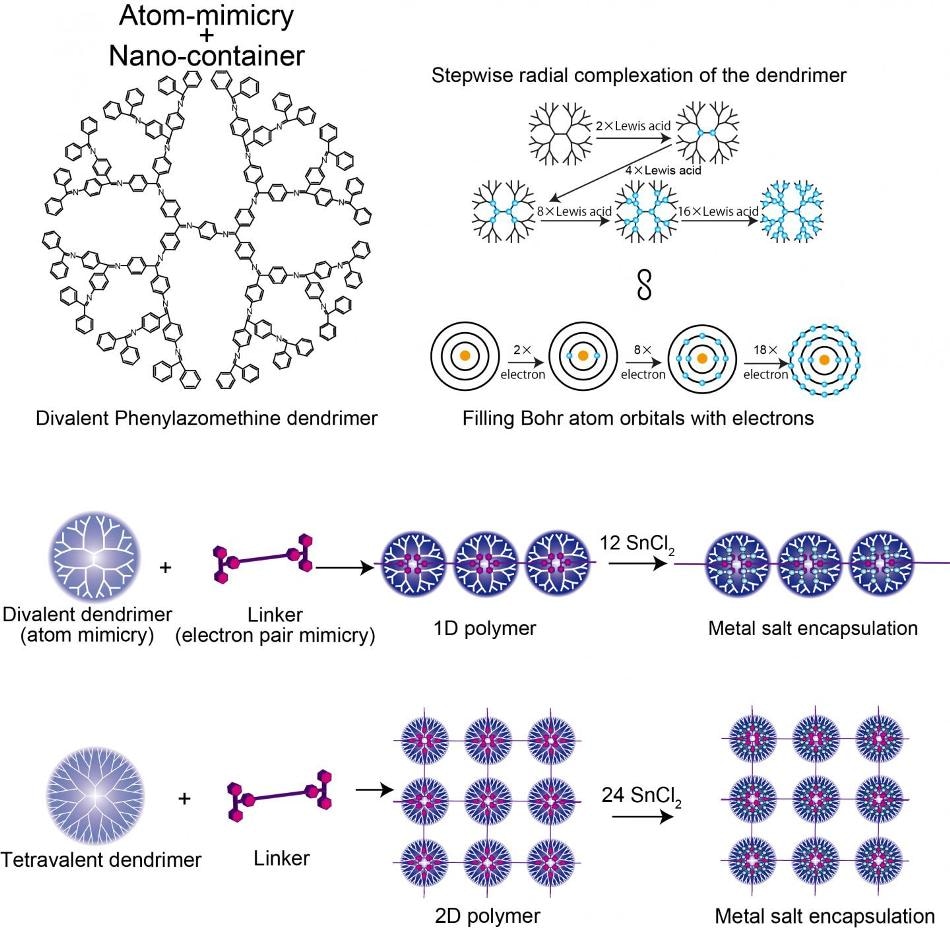Dec 5 2016
 This image shows the structure of Divalent Phenylazomenthine dendrimer, Comparison of the DPA and Bohr atom model, and 1D/2D supramolecular polymer. Credit: Tokyo Institute of Technology
This image shows the structure of Divalent Phenylazomenthine dendrimer, Comparison of the DPA and Bohr atom model, and 1D/2D supramolecular polymer. Credit: Tokyo Institute of Technology
Control plays a significant role in nanotechnology. Control over the distances between nanoparticles and also the arrangements can allow customized interaction strengths in order to harness properties in devices such as plasmonic sensors.
Researchers at Tokyo Institute of Technology are currently using dendrimers that mimic the electron valency of atoms and bind them into arrays using molecules that synchronize with the dendrimer as they would develop a covalent electron pair in their valence shell - "electron pair mimicry".
The dendritic polyphenylazomethine (DPA), which comprises of a structure that branches out from a central core, was considered by Kimihisa Yamamoto, Ken Albrecht, and colleagues at Tokyo Tech. "Lewis acid" molecules are found to coordinate with the "Lewis base" sites of DPA.
A study of the ratio of SnCl2 Lewis acid molecules coordinating with every single dendrimer highlighted step increases ranging from 2 to 4 to 8 to 16, which mimics the valency of the Bohr atom that has 2, 8, 18, and 32 electrons in the 1st, 2nd, 3rd , and 4th orbitals.
This highlights the increase in the number of molecules capable of coordinating with the dendrimer together with increasing distance from the core, as the number of dendrimer branches and electron density experience an increase.
Yamamoto's team studied the coordination of DPA with triphenylmethylium (TPM), a stronger binding Lewis acid, bound to phenylene ethynylene, which is a rod-like molecule. The firmness of the phylene ethynlene backbone prevents binding of the acid cations, at either end, to the same dendrimer.
A polymer chain of dendrimers is instead developed. A different starting dendrimer (ZnPG4 instead of DPAG4) was used to develop two dimensional polymerization of the dendrimers, producing a 2D array of nanocontainers for that can lead to the accumulation of other Lewis acids into the outer orbitals. ZnPG4 has a core valency of four instead of two.
The researchers highlight that the work explains "a new aspect of atom mimicry". They further state, “the geometry and pitch can be controlled by the design of the dendrimer and the linker and are potentially applicable to plasmonics (after seed-mediated growth) and nanoelectrode grids (which are also useful as electrocatalysts)."
Background
Bohr Atom
The Bohr model of the atom developed in 1913 by Niels Bohr and Ernest Rutherford describes the atom as a positive nucleus that is surrounded by electrons in varied energy levels or shells. Every single shell has a prescribed number of electrons that can occupy it, in other words, the first shell can be occupied by two electrons, the next shell by eight, followed by eighteen in another shell and so on.
This model proves to be successful in explaining the spectral emission lines even though there are a few aspects of the behavior of the atom that the model does not cover. An electron jumps to the next energy level when excited. After returning to the initial energy level, the variation in the energies is emitted as light at a particular wavelength corresponding to the energy difference.
Bonding of the atom with another chemical species is possible when the shell is not full. In this way the valency of an atom explains how full the electron shell is and also the possibility of readily developing bonds. The electron density gradient of dendrimers traveling from the core to the more branched outer regions describes how many Lewis acid coordinating molecules it is capable of accommodating and in this way it mimics the energy levels of the Bohr atom.
What is a Lewis acid
A Lewis acid refers to a chemical species capable of accepting a lone pair of electrons from a chemical that has the potential to donate a lone pair, that is, from a Lewis base. The structure of the chemical defines this behavior. Lewis acids include metal cations and acidic compounds.
Coordinating of the dendrimer with the Lewis acids allows it to take the place of the Lewis base that would then donate an electron pair. The di-Lewis acid compound (linker molecule) is described as electron pair mimicry by the researchers.
Isosbestic Points
The reaction of two chemicals leads to a change in the amount of light absorbed. This change is based on how much light is absorbed by the products and the reactants. If the same amount of light is absorbed by the products and reactants at a specific wavelength, it is described as the isosbestic point.
Isosbestic points were used by the researchers to identify the step increases in Lewis acid reacting with the dendrimers. Coordination of the Lewis acid to the subsequent layer of the dendrimer is indicated by a wavelength shift in the isosbestic point.